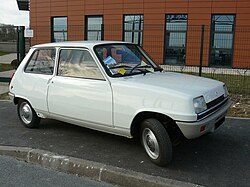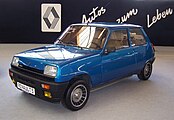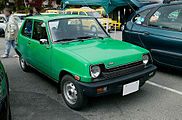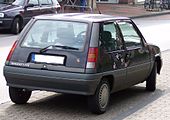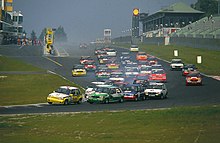Renault 5
| Renault 5 / Super 5 | |
|---|---|
| Production period: | 1972-1996 |
| Class : | Small car |
| Body versions : | Station wagon |
| Previous model: | Renault 4 |
| Successor: | Renault Clio I. |
The Renault 5 - R5 for short - was a small car produced between the beginning of 1972 and the end of 1996 by the French vehicle manufacturer Renault . The concept originally came from Bernard Hanon, a professor of management at New York University, and was called Project 122 .
R5 (1972–1985)
| First generation | |
|---|---|
|
Renault 5 three-door (1972–1984) |
|
| Production period: | 1972-1985 |
| Body versions : | Station wagon |
| Engines: |
Otto engines : 0.8–1.4 liters (25–79 kW) |
| Length: | 3520 mm |
| Width: | 1550 mm |
| Height: | 1410 mm |
| Wheelbase : | 2405-2335 mm |
| Empty weight : | from 735 kg |
Originally intended as a supplement to the Renault 4 and as a more modern and cheaper alternative to the Renault 6 , the R5 developed into a sales success after its introduction in March 1972. This was mainly due to the low cost and compact dimensions. The car had a self-supporting body without the platform frame of the R4 and R6. The independent suspension with torsion bars was similar to that of the R4, but was simpler and made up of fewer parts.
The R5 was initially only available as a three-door hatchback. The five-door variant followed in the summer of 1979.
There are different engine variants from 0.8 to 1.4 l, most recently also with turbocharging in the R5 Alpine Turbo (122B) with 79 kW (107 PS); However, it is not the much more powerful R5 Turbo developed for competitions . A four-cylinder engine with 782 cm³ displacement, which comes from the Renault 4, served as the base engine. It has an output of 25 kW (34 hp), but was only used in France. In Germany, the engine with 845 cm³ displacement and an output of 26 kW (36 hp) was introduced as the basic engine. The engine sits lengthways behind the front axle, the transmission in front. Early R5s have a turret gearshift like the R4 , later there was a middle gearshift, which was initially a bit wobbly.
In 1975 Renault built a sportier engine with 68 kW (93 hp) under the name "Alpine", which enables a top speed of 173 km / h. Six years later, this engine was boosted by a turbocharger. The engine has knock control, but no intercooler, and the carburetor is placed in front of the turbocharger, which reduced construction costs; this is where the R5 Alpine Turbo differs from the Renault 18 Turbo, for example . The performance of the Renault 5 Alpine Turbo increased to 79 kW (107 PS) at 6000 rpm and enables a top speed of 185 km / h according to the manufacturer. The acceleration from 0 to 100 km / h was completed in 9.1 seconds, at 4000 rpm the maximum torque of 149 Nm is delivered, 95% of which already at 2500 rpm. The Renault 5 Turbo came on the market in 1980. Its engine has an output of 118 kW (160 hp). The last version in 1985 under the name Renault Maxi 5 Turbo developed 300 kW (408 hp) and was homologated in FIA Group B for rally use and was also designed for race tracks.
| L (France) | 782 cc | 25 kW (34 PS) | 10.1972-08.1984 |
| L (Germany) | 845 cc | 26 kW (36 hp) | 01.1972-08.1984 |
| TL | 956 cc | 32 kW (44 PS) | 01.1972-12.1984 |
| GTL | 1289 cc | 31 kW (42 hp) | 09.1976-09.1979 |
| Automatic | 1289 cc | 40 kW (55 PS) | 06.1979-12.1984 |
| TS | 1289 cc | 47 kW (64 PS) | 09.1975-08.1984 |
| Alpine | 1397 cc | 68 kW (93 hp) | 09.1977-09.1981 |
| Alpine Turbo | 1397 cc | 79 kW (108 PS) | 09.1980-12.1984 |
| turbo | 1397 cc | 118 kW (160 PS) | 06.1980-12.1985 |
From the GTL version there was an electric rear window wiper / washer system and rear vent windows, from the TS version there was an electric windscreen washer system, tachometer and sports seats with integrated headrests. The Renault 5 Alpine also has a standard 5-speed manual transmission, a boost pressure indicator, stiffer front springs and a reinforced stabilizer on the front axle.
Based on the Renault 5, the compact sports car Renault 5 Turbo was created in 1980 . When low-emission vehicles were tax-privileged in Germany, the catalytic converter version of the R5 would have been the only small car that would have come under this rule if it had not only applied from 1.4 l displacement. This was later corrected by a court ruling after owners of R5 sued with catalysts.
Renault 5 Turbo (1980–1982)
Export models
In the UK , the R5 Alpine and R5 Alpine Turbo sports models were marketed as the R5 Gordini and R5 Gordini Turbo. The car with additional chrome-plated components and catalytic converter was exported to the USA as the Renault Le Car . With copies sold in 1776, however, he was not very successful there. In Europe, the Le Car Van was also offered, which was optically based on an American van.
A notchback variant was built for the Spanish market at FASA-Renault in Valladolid (Spain) from late 1974 to early 1983 and sold as Renault Siete (from 1979: Renault 7). They did not want to compromise the image of the R5, which had been built up in other markets, with a notchback model that was regarded as conservative in this vehicle class.
R5 ("Supercinq", 1984–1996)
| Second generation | |
|---|---|
|
Renault 5 five-door (1984–1987) |
|
| Production period: | 1984-1996 |
| Body versions : | Station wagon |
| Engines: |
Otto engines : 1.0–1.7 liters (30–88 kW) Diesel engines : 1.6 liters (40 kW) |
| Length: | 3590-3650 mm |
| Width: | 1520 mm |
| Height: | 1400 mm |
| Wheelbase : | 2405-2465 mm |
| Empty weight : | 785-935 kg |
The successor to the first Renault 5 was presented in September 1984 and sold from January 1985. The shape of the "Supercinq" designed by Marcello Gandini was matched to that of the original model, but the platform with the transverse engine at the front essentially came from the Renault 9 . The engine was still the Cléon-Fonte, the first version of which appeared in the Renault 8 in 1962 . From 1986 there was a lambda control and three-way catalytic converter, and a diesel engine was also introduced.
Renault advertised the vehicles with vector graphic images typical of the time as the first in the group to be produced using the “most modern CAD / CAM methods” and emphasized the concept of vehicle operation based on ergonomic knowledge.
The body was self-supporting, the front axle consisted of a subframe with MacPherson struts and wishbones. The rear wheels were suspended on parallel swing arms with torsion bar springs and telescopic shock absorbers installed horizontally. In repair lists, the R5 of the second series is also marked as "Super 5".
On the basis of the R5, a high-roof estate was also manufactured, which replaced the Renault 4 F6 (Fourgonnette) and was named Renault Rapid (Germany), Renault Express (for example in France, Austria, Spain, Switzerland, Italy) and Renault Extra (Great Britain, Ireland ) was distributed.
Facelift
In June 1987 the radiator grille was changed and the rhombus moved to the left.
The second series of Renault 5, also known as Supercinq , German Super 5 , was produced in France in Flins-sur-Seine, Billancourt and Dieppe until December 1990 , and in Vilvoorde (Belgium) and in Setúbal (Portugal) until July 1994 at FASA-Renault in Valladolid (Spain, also called Supercinco there) and until December 1996 from Revoz in Novo mesto (Yugoslavia, from 1991 Slovenia).
The R5 remained on offer until mid-1994, most recently with a diesel engine or as a special Campus model .
Engines
The following engines were available
| Base | 956 cc | 30 kW (41 hp) | 10.1984-10.1988 |
| C / L / campus | 1108 cc | 33 kW (45 PS) | 10.1984-10.1988 |
| TC / TL | 1397 cc | 43 kW (58 hp) | 10.1985-12.1996 |
| SR / TR / GTR | 1397 cc | 44 kW (60 hp) | 10.1984-06.1988 |
| TS / GTS / TSE | 1397 cc | 49 kW (67 hp) | 06.1987-07.1989 |
| TL / GTL / GTR | 1397 cc | 52 kW (71 hp) | 10.1984-07.1989 |
| GTX | 1721 cc | 54 kW (73 hp) | 10.1986-07.1994 |
| GTX / Exclusive | 1721 cc | 64 kW (88 hp) | 06.1987-06.1994 |
| GTE | 1721 cc | 69 kW (94 PS) | 10.1986-08.1991 |
| GT Turbo | 1397 cc | 85 kW (115 PS) | 04.1985-08.1990 |
| SD / TD / GTD | 1596 cc | 40 kW (54 PS) | 08.1985-12.1996 |
- 1.7 liter models with 65 kW (88 hp) before July 1989 had a double carburetor and an uncontrolled catalytic converter.
GT Turbo and GTE
From April 1985, sporty versions of the Super 5 were produced again, with the GT Turbo initially coming onto the market. This had a 1.4 liter turbo engine with an initial (phase 1) 85 kW (115 hp) and a torque of 164 Nm at 3000 rpm. From 1987 (phase II), the output increased to 88 kW (120 hp) and the torque to 165 Nm at 3750 rpm. For a long time, the R5 GT Turbo was the fastest small series production car ever built with a design speed of 201 km / h according to the type certificate, with which the red speed range was reached in 5th gear. The interaction of the 55 kW base engine from the R5 GTL, supported by a Garrett T3 turbocharger and a weight of 822 kg, enabled a sprint from 0 to 100 in 7.9 seconds. The thermals caused major problems for the GT-turbo due to the hot turbocharger and the relatively narrow radiator with internal oil cooler. While the GT Turbo in its first series was still equipped with widenings in anthracite plastic and LM rims without a center hole, after the GTE was released, the widenings and the modified radiator grille were painted in the body color, the design of the light metal rims changed and a small rear spoiler appropriate.
As standard, the vehicles were fitted with tires from the Michelin brand, type MXV in the dimension 195 / 55-13. The introduction of the catalytic converter prompted Renault to stop offering the GT Turbo in some countries from 1987 onwards and instead to produce the GTE in its own look .
The R5 GTE , introduced in autumn 1986, had a 1.7-liter naturally aspirated engine (F-engine) installed and produced 69 kW (94 PS) with G-Kat and 71 kW (97 PS) without Kat. The GTE was but not as sporty as the GT Turbo , because the power was lacking and the vehicle weight was a bit higher. On the other hand, with the GTE injection model, there were no temperature problems due to the hot turbocharger and the resulting fluctuations in performance, as well as the high fuel consumption when driving quickly.
The R5 GT Turbo was primarily intended for motorsport. Because of the constant risk of overheating, it was unsuitable for practical use. Well-preserved models are extremely rare today and are considered by connoisseurs as enthusiast vehicles, while the GTE never achieved the popularity of the GT Turbo .
While the GT Turbo was mainly delivered in white, red, blue metallic and black (white and black, each with a red carpet), the dark blue version (Le Mans blue metallic) of the GTE was very popular.
The production of the GT Turbo ended in August 1990, that of the GTE ended with the appearance of the Clio 16V in August 1991.
Special models
Especially towards the end of the construction period, the R5 was offered in a large number of special models with colorful fabric seats and additional equipment. Examples are the special models Flash , Primus , Prima , Tiga and the Campus .
The R5 Campus , which was offered from the beginning of 1988 , is a basic equipment variant without any extras with the 43 kW engine of the R5 C. This model was also offered until mid-1992 after the introduction of the R5 successor Clio .
It is interesting that the entry-level models had a completely different dashboard made of gray hard plastic with the instrument cluster of the original R5, which was made from one piece. Better models (from GTL) had the usual instrument cluster, as u. a. was used in the Espace and which had a pointer instrument for the oil level. The dashboards were shaped completely differently and also padded. They had integrated switch strips and were often colored to match the color of the upholstery.
The special model R5 Exclusiv (in France, Benelux, Spain and Austria Baccara , in Great Britain Monaco and in Italy Limited ) waited with a significantly better sound insulation, deep-pile velor carpets, a special rear shelf with a large storage compartment made of leather, aluminum rims (tires: 165 / 65R13) , a hydraulic power steering, the leather steering wheel and the gear knob from the GTE model, a beige full leather interior, electric window lifters, infrared-controlled central locking ("Plip") of the 1721 cm³ carburettor engine with 64 kW (87 hp), an uncontrolled catalytic converter and 180 km / h top speed. The acceleration from 0 to 100 km / h was given as 9.8 seconds. This model was delayed by the internally ventilated disc brakes of the turbo. According to the factory, consumption was between 5.3 and 10.7 liters of super unleaded per 100 km. In some countries, the Baccara or Monaco was also offered in an automatic version with a 1397 cm³ engine with 67PS (C2J engine, carburetor, 3-stage automatic). From 1989 Renault introduced regulated catalytic converters as standard in many countries, for this purpose the special model Baccara was equipped with the 1721 cm³ engine with monopoint injection and an output of 54 kW / 73 HP (engine type F3N, regulated catalytic converter, low-emission according to US standards). In this variant, the power steering was no longer standard, and the internally ventilated disc brakes on the front axle were also omitted.
In general, the engines of this special model suffered from warped carburetors, as it was sitting above the hot manifold at the rear between the engine and the bulkhead and was exposed to severe thermal loads. Renault tried to get the problem under control by means of complex carburetor base seals, but only planning the carburetor brought a permanent solution. The Renault 5 Exclusiv was built around 4,000 times and only offered in the colors metallic black, champagne and metallic brown. The recommended retail price in 1987 was DM 21,900.
Convertible
Between the end of 1986 and the beginning of 1991, the Belgian company EBS also produced a convertible version with a total of 1400 vehicles, 14 of which were GT Turbo.
Motorsport
With the Renault 5, a national and international cup was also held from 1974 . The participating vehicles, some of which were more powerful, included the R5 TL (56 PS), LS (64 PS), TS (85 PS), Alpine (R1223) with 68 kW (93 PS) and, from 1981, the Renault 5 Turbo with 118 kW (160 hp).
License replicas
From 1977 the Renault 5 was offered under license from SAIPA . The five-door R5 was sold by the car manufacturer Pars Khodro as the Sepand and until 2013 as the Renault PK with a 1.3-liter petrol engine and automatic air conditioning. Iran imported original French parts for this.
Web links
Individual evidence
- ↑ a b c d e f g Renault Club: Rhombus 03-2012 . 2012.
- ↑ Technical specification RENAULT 5 1.0 (1972)
- ↑ a b M. Bartels: Renault R5 Alpine Turbo . In: ATZ Automobiltechnische Zeitschrift . 1982th edition. No. 7-8 . Franckh'sche Verlagshandlung, Stuttgart, p. 357 .
- ↑ Focus article about 40 years of Renault 5
